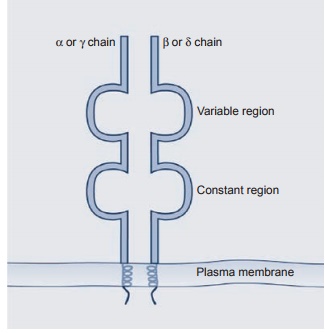Chapter: Essential Clinical Immunology: Basic Components of the Immune System
T Cells and their Receptors

T CELLS AND THEIR RECEPTORS
Each T cell is also committed to a
given antigen and recognizes it by one of two TCRs. They may have TCR2s
composed of gamma (γ) and
delta (δ) chains
or TCR2s composed of another heterodimer of alpha (α) and beta (β) chains. These TCR2s are
associated with a group of transmem-brance proteins on the CD3 molecule, which
takes the antigen recognition sig-nal inside the cell. Signal transduction via
the CD3 complex is regulated by a series of kinases, which are associated with
the tails of the CD3–TCR complex and regulate phosphorylation. Deficiencies or
blocks in the T-cell signaling pathways either atthe cell-surface complex or at
the level of the kinases may result in various forms of immunodeficiency. Two
other important antigens present on TCR2 cells recognize histocompatibility
antigens and will be discussed later. The genes for TCR chains are on different
chromosomes with the β and α molecules on chromosome 7, while
the α and δ are on chromosome 14. As seen in
Figure 1.5, the four chains are made up of a variable region and a constant
region similar to those observed with the immu-noglobulins. The variable
regions are also numerous and joined at D and J regions by RAG1 and
RAG2. This permits a diver-sity of antigen recognition similar to
that observed with immunoglobulin, but addi-tional somatic mutation is not
involved in T cells. These similarities have led to the concept that genes for
antigen-specific T cells evolved in the same manner as immu-noglobulin from a
parent gene, and both are members of a superantigen family
The TCR
complex recognizes small peptides presented to it by the MHC class I and II and
depends on the type of T cell.

Figure 1.5 Diagram of the structure of a T-cell receptor.
Helper T
cells (CD4) recognize class II anti-gens while suppressor cytotoxic T cells
(CD8) recognize class I antigens. Because of the rather low affinity of the
reactions, recognition of processed antigen alone is not sufficient to activate
T cells. Soluble interleukins are needed to complete the picture and are
generated during the anti-gen processing.
Related Topics